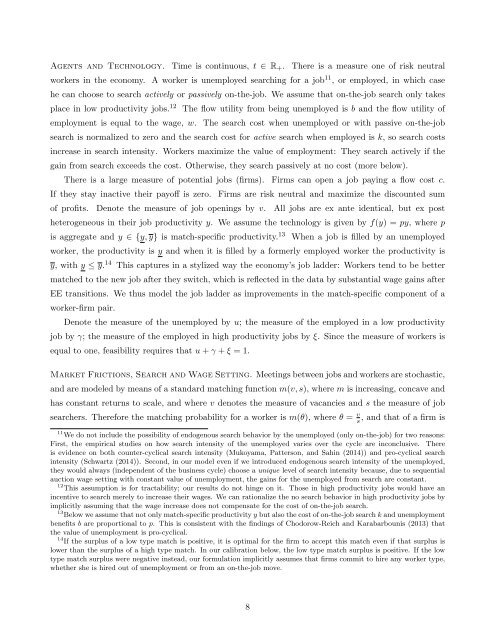Unemployment cycles
WP201526
WP201526
Create successful ePaper yourself
Turn your PDF publications into a flip-book with our unique Google optimized e-Paper software.
Agents and Technology. Time is continuous, t ∈ R + . There is a measure one of risk neutral<br />
workers in the economy. A worker is unemployed searching for a job 11 , or employed, in which case<br />
he can choose to search actively or passively on-the-job. We assume that on-the-job search only takes<br />
place in low productivity jobs. 12<br />
The flow utility from being unemployed is b and the flow utility of<br />
employment is equal to the wage, w. The search cost when unemployed or with passive on-the-job<br />
search is normalized to zero and the search cost for active search when employed is k, so search costs<br />
increase in search intensity. Workers maximize the value of employment: They search actively if the<br />
gain from search exceeds the cost. Otherwise, they search passively at no cost (more below).<br />
There is a large measure of potential jobs (firms). Firms can open a job paying a flow cost c.<br />
If they stay inactive their payoff is zero.<br />
Firms are risk neutral and maximize the discounted sum<br />
of profits. Denote the measure of job openings by v. All jobs are ex ante identical, but ex post<br />
heterogeneous in their job productivity y. We assume the technology is given by f(y) = py, where p<br />
is aggregate and y ∈ {y, y} is match-specific productivity. 13<br />
When a job is filled by an unemployed<br />
worker, the productivity is y and when it is filled by a formerly employed worker the productivity is<br />
y, with y ≤ y. 14 This captures in a stylized way the economy’s job ladder: Workers tend to be better<br />
matched to the new job after they switch, which is reflected in the data by substantial wage gains after<br />
EE transitions. We thus model the job ladder as improvements in the match-specific component of a<br />
worker-firm pair.<br />
Denote the measure of the unemployed by u; the measure of the employed in a low productivity<br />
job by γ; the measure of the employed in high productivity jobs by ξ. Since the measure of workers is<br />
equal to one, feasibility requires that u + γ + ξ = 1.<br />
Market Frictions, Search and Wage Setting. Meetings between jobs and workers are stochastic,<br />
and are modeled by means of a standard matching function m(v, s), where m is increasing, concave and<br />
has constant returns to scale, and where v denotes the measure of vacancies and s the measure of job<br />
searchers. Therefore the matching probability for a worker is m(θ), where θ = v s<br />
, and that of a firm is<br />
11 We do not include the possibility of endogenous search behavior by the unemployed (only on-the-job) for two reasons:<br />
First, the empirical studies on how search intensity of the unemployed varies over the cycle are inconclusive. There<br />
is evidence on both counter-cyclical search intensity (Mukoyama, Patterson, and Sahin (2014)) and pro-cyclical search<br />
intensity (Schwartz (2014)). Second, in our model even if we introduced endogenous search intensity of the unemployed,<br />
they would always (independent of the business cycle) choose a unique level of search intensity because, due to sequential<br />
auction wage setting with constant value of unemployment, the gains for the unemployed from search are constant.<br />
12 This assumption is for tractability; our results do not hinge on it. Those in high productivity jobs would have an<br />
incentive to search merely to increase their wages. We can rationalize the no search behavior in high productivity jobs by<br />
implicitly assuming that the wage increase does not compensate for the cost of on-the-job search.<br />
13 Below we assume that not only match-specific productivity y but also the cost of on-the-job search k and unemployment<br />
benefits b are proportional to p. This is consistent with the findings of Chodorow-Reich and Karabarbounis (2013) that<br />
the value of unemployment is pro-cyclical.<br />
14 If the surplus of a low type match is positive, it is optimal for the firm to accept this match even if that surplus is<br />
lower than the surplus of a high type match. In our calibration below, the low type match surplus is positive. If the low<br />
type match surplus were negative instead, our formulation implicitly assumes that firms commit to hire any worker type,<br />
whether she is hired out of unemployment or from an on-the-job move.<br />
8


